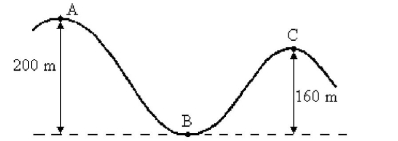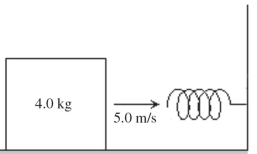A) 2.8 N
B) 5.6 N
C) 4.2 N
D) 0.70 N
E) 1.4 N
G) A) and B)
Correct Answer

verified
Correct Answer
verified
Short Answer
How many joules of energy are used by a 2.0 hp motor that runs for 1.0 hour? (1 hp = 746 W)
Correct Answer

verified
Correct Answer
verified
Short Answer
You want to store 1,000 J of energy in an ideal spring when it is compressed by only 2.5 cm. What should be the force constant (spring constant) of this spring?
Correct Answer

verified
Correct Answer
verified
Short Answer
Suppose you left five 100-W light bulbs burning in the basement for two weeks. If electricity costs 10.0¢/kW·h, (a) how much did the electricity cost (to the nearest dollar) to leave those bulbs on, and (b) how many joules of electrical energy did they consume?
Correct Answer

verified
Correct Answer
verified
Short Answer
A very light ideal spring of spring constant (force constant) 2.5 N/cm is 15 cm long when nothing is attached to it. It is now used to pull horizontally on a 12.5-kg box on a perfectly smooth horizontal floor. You observe that the box starts from rest and moves 96 cm during the first 1.6 s of its motion with constant acceleration. How long is the spring during this motion?
Correct Answer

verified
19 cm
Correct Answer
verified
Multiple Choice
A toy rocket that weighs 10 N blasts straight up from ground level with an initial kinetic energy of 40 J. At the exact top of its trajectory, its total mechanical energy is 140 J. To what vertical height Above the ground does it rise, assuming no air resistance?
A) 14 m
B) 10 m
C) 24 m
D) 1.0 m
F) A) and B)
Correct Answer

verified
Correct Answer
verified
Multiple Choice
A heavy frog and a light frog jump straight up into the air. They push off in such away that they both have the same kinetic energy just as they leave the ground. Air resistance is negligible. Which Of the following statements about these frogs are correct? (There could be more than one correct Choice.)
A) The heavier frog goes higher than the lighter frog.
B) The lighter frog goes higher than the heavier frog.
C) They both leave the ground with the same speed.
D) Just as they leave the ground, the heavier frog is moving faster than the lighter frog.
E) Just as they leave the ground, the lighter frog is moving faster than the heavier frog.
F) Both frogs reach the same maximum height.
H) E) and F)
Correct Answer

verified
Correct Answer
verified
Multiple Choice
A driver, traveling at 22 m/s, slows down her 2000 kg truck to stop for a red light. What work is done on the truck by the friction force of the road?
A)
B)
C)
D)
F) A) and C)
Correct Answer

verified
Correct Answer
verified
Short Answer
A 7.5-kg otter slides down a hill, starting from rest at the top. The sloping surface of the hill is 8.8 m long, and the top is 6.5 m above the base. If the speed of the otter at the bottom of the hill is 9.2 m/s, how much energy was lost to nonconservative forces on the hill?
Correct Answer

verified
Correct Answer
verified
Multiple Choice
What is the net power needed to change the speed of a 1600-kg sport utility vehicle from 15.0 m/s to 40.0 m/s in 4.00 seconds?
A) 14.0 kW
B) 275 kW
C) 100 kW
D) 10.0 kW
E) 140 kW
G) A) and D)
Correct Answer

verified
Correct Answer
verified
Multiple Choice
A 1000-kg car is moving at 15 km/h. If a 2000-kg truck has 23 times the kinetic energy of the car, how fast is the truck moving?
A) 72 km/h
B) 41 km/h
C) 51 km/h
D) 61 km/h
F) All of the above
Correct Answer

verified
Correct Answer
verified
Multiple Choice
A 4.0 kg object is moving with speed 2.0 m/s. A 1.0 kg object is moving with speed 4.0 m/s. Both objects encounter the same constant braking force, and are brought to rest. Which object travels The greater distance before stopping?
A) the 1.0 kg object
B) the 4.0 kg object
C) Both objects travel the same distance.
D) It cannot be determined from the information given.
F) All of the above
Correct Answer

verified
Correct Answer
verified
Multiple Choice
In a ballistics test, a 28-g bullet pierces a sand bag that is 30 cm thick. If the initial bullet velocity was 55 m/s and it emerged from the sandbag moving at 18 m/s, what was the magnitude of the Friction force (assuming it to be constant) that the bullet experienced while it traveled through the Bag?
A) 13 N
B) 1.3 N
C) 130 N
D) 38 N
F) A) and C)
Correct Answer

verified
Correct Answer
verified
Multiple Choice
A bead is moving with a speed of 20 m/s at position A on the track shown in the figure. This track is friction-free, and there is no appreciable air resistance. What is the speed of the bead at point C?

A) 0 m/s
B) 69 m/s
C) 20 m/s
D) 34 m/s
E) We cannot solve this problem without knowing the mass of the bead.
G) A) and B)
Correct Answer

verified
Correct Answer
verified
Multiple Choice
A crane lifts a 425 kg steel beam vertically upward a distance of 95 m. How much work does the crane do on the beam if the beam accelerates upward at 1.8 m/s²? Neglect frictional forces.
A)
B)
C)
D)
F) A) and C)
Correct Answer

verified
Correct Answer
verified
Short Answer
As shown in the figure, a 4.0-kg block is moving at 5.0 m/s along a horizontal frictionless surface toward an ideal spring that is attached to a wall. After the block collides with the spring, the spring is compressed a maximum distance of 0.68 m. What is the speed of the block when the spring is compressed to only one-half of the maximum distance?

Correct Answer

verified
Correct Answer
verified
Multiple Choice
A 100-N force has a horizontal component of 80 N and a vertical component of 60 N. The force is applied to a cart on a level frictionless floor. The cart starts from rest and moves 2.0 m horizontally Along the floor due to this force. What is the cart's final kinetic energy?
A) 120 J
B) 160 J
C) zero
D) 200 J
F) All of the above
Correct Answer

verified
Correct Answer
verified
Multiple Choice
A spring-loaded dart gun is used to shoot a dart straight up into the air, and the dart reaches a maximum height of 24 meters. The same dart is shot up a second time from the same gun, but this Time the spring is compressed only half as far (compared to the first shot) . How far up does the Dart go this time (neglect all friction and assume the spring is ideal) ?
A) 12 m
B) 6.0 m
C) 48 m
D) 3.0 m
F) B) and C)
Correct Answer

verified
B
Correct Answer
verified
Multiple Choice
A 30-N box is pulled upward 6.0 m along the surface of a ramp that rises at above the horizontal. How much work does gravity do on the box during this process?
A) -110 J
B) -140 J
C) -1100 J
D) -180 J
E) 120 J
G) C) and D)
Correct Answer

verified
Correct Answer
verified
Multiple Choice
A stone is moving on a rough level surface. It has 24 J of kinetic energy, and the friction force on it is a constant 0.50 N. What is the maximum distance it can slide?
A) 24 m
B) 12 m
C) 48 m
D) 2.0 m
F) A) and D)
Correct Answer

verified
C
Correct Answer
verified
Showing 1 - 20 of 153
Related Exams